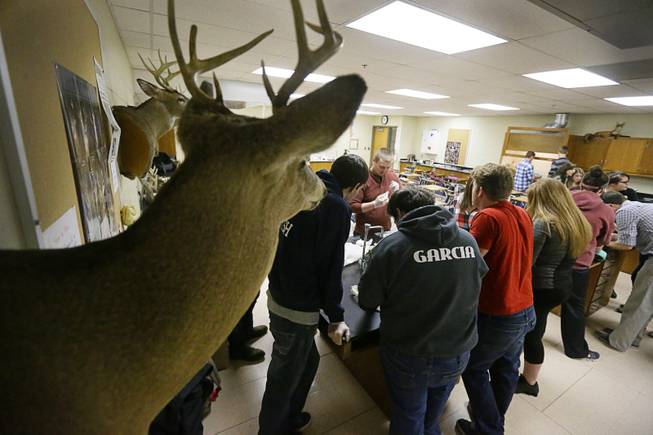
Carlos Osorio / AP
In a photo from Jan. 19, 2016, Croswell-Lexington High School students work on their projects during the school’s taxidermy class in Croswell, Mich. Each student in the 13-week class is responsible for bringing in an animal that he or she hunted, trapped or found dead.
Friday, April 1, 2016 | 12:12 a.m.
CROSWELL, Mich. — Students all over the U.S. dissect animals as a kind of high school rite of passage.
Not many, though, stuff and mount the critters afterward.
A Michigan high school is teaching students to do just that.
Croswell-Lexington High offered a taxidermy course for the first time this school year. So far, it's been a hit.
Sixty students enrolled in the first two sections, and about a dozen had to be turned away, said Ryan Cayce, the principal at the school about 80 miles north of Detroit in a community near Lake Huron that long has embraced hunting and fishing.
Teacher Kyle Tubbs, who owns a taxidermy business, last year pitched the idea of a stand-alone class to Cayce, who gave it the green light.
Senior Matt Barker, a trapper and hunter, said the course is perfect for him.
"This is one of the best classes that I've had, because it's a very hands-on class," Barker said, taking a break from fleshing an opossum he trapped in his grandfather's backyard.
Students in the 13-week class must bring in an animal that they hunted, trapped or found dead. Road kill counts.
In Mieyah Brenton's case, the red-bellied woodpecker the senior worked on was a gift from the family cat.
"I just want this eye to be where it's supposed to," an exasperated Brenton said to her lab mates before jamming a blade into the bird's eye.
Brenton said many people think the class is gross, but "it's just kind of something that's cool to learn, especially if you like biology."
The class meets state standards for science instruction, Tubbs said.
Many students in the taxidermy class already have taken biology, Cayce said.
"It fits in and integrates well with the other physical science courses," he said.
And art, said Tubbs, who points out that students who mount a full-bodied animal are asked to create its natural habitat, which could include representations of water, dirt and plants.
"Trying to make something dead look like something that's living again takes ... skill," said Claire Knapp, a junior who was drawn to learning about taxidermy after taking an anatomy course.
For the students who didn't make it into the inaugural offering, there's always next school year.
"I never thought that it would be this popular and (have) this much interest," Tubbs said. "It's just really cool for me, doing taxidermy and as a teacher, to see the interest that we have with this class."

Join the Discussion:
Check this out for a full explanation of our conversion to the LiveFyre commenting system and instructions on how to sign up for an account.
Full comments policy